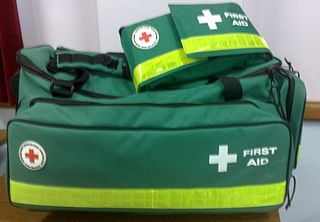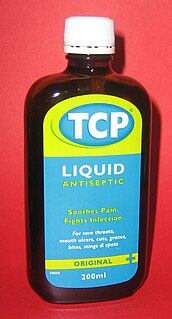
A first aid kit is a collection of supplies and equipment that is used to give medical treatment. There is a wide variation in the contents of first aid kits based on the knowledge and experience of those putting it together, the differing first aid requirements of the area where it may be used, and variations in legislation or regulation in a given area.

Benzalkonium chloride, also known as alkyldimethylbenzylammonium chloride (ADBAC) and by the trade name Zephiran, is a type of cationic surfactant. It is an organic salt classified as a quaternary ammonium compound. ADBACs have three main categories of use: as a biocide, a cationic surfactant, and a phase transfer agent. ADBACs are a mixture of alkylbenzyldimethylammonium chlorides, in which the alkyl group has various even-numbered alkyl chain lengths.

Flying ointment is a hallucinogenic ointment said to have been used by witches in the practice of European witchcraft from at least as far back as the Early Modern period, when detailed recipes for such preparations were first recorded.

A topical medication is a medication that is applied to a particular place on or in the body. Most often topical administration means application to body surfaces such as the skin or mucous membranes to treat ailments via a large range of classes including creams, foams, gels, lotions, and ointments. Many topical medications are epicutaneous, meaning that they are applied directly to the skin. Topical medications may also be inhalational, such as asthma medications, or applied to the surface of tissues other than the skin, such as eye drops applied to the conjunctiva, or ear drops placed in the ear, or medications applied to the surface of a tooth. The word topical derives from Greek τοπικόςtopikos, "of a place".
Neomycin/polymyxin B/bacitracin, also known as triple antibiotic ointment, is a medication used to reduce the risk of infections following minor skin injuries. It contains three antibiotics: neomycin, polymyxin B, and bacitracin. It is for topical use only and should not be ingested due to risk of kidney damage.

TCP is a mild antiseptic, produced in France by Laboratoires Chemineau in Vouvray and sold in the United Kingdom by Omega Pharma.

Merbromin is an organomercuric disodium salt compound used as a topical antiseptic for minor cuts and scrapes and as a biological dye. Readily available in most countries, it is no longer sold in Switzerland, Brazil, France, Iran, Germany, or the United States due to its mercury content.

Panthenol (also called pantothenol) is the alcohol analog of pantothenic acid (vitamin B5), and is thus a provitamin of B5. In organisms, it is quickly oxidized to pantothenic acid. It is a viscous transparent liquid at room temperature. Panthenol is used in pharmaceutical and cosmetic products as a moisturizer and to improve wound healing.
Germolene is the brand name used on a range of antiseptic products produced by the Bayer company, who purchased the brand from GlaxoSmithKline, then known as Smithkline Beecham, in 1999. It is manufactured for Bayer UK by the Devon based Wrafton Laboratories division of US over-the counter and supermarket own-label preparation producer Perrigo.

Bag Balm is a salve developed in 1899 to soothe irritation on cows' udders after milking. Bag Balm is widely used to soothe dry, cracked skin on humans.
Fibrinolysin is an enzyme derived from plasma of bovine origin (plasmin) or extracted from cultures of certain bacteria. It is used locally only and exclusively together with the enzyme desoxyribonuclease. Fibrinolysin and desoxyribonuclease both act as lytic enzymes. The combination is available as ointment containing 1 BU fibrinolysin and 666 BUs desoxyribonuclease per gram.
Resinol is a skin protectant and topical analgesic that is made by ResiCal Inc. from Orchard Park, New York. It is an over-the-counter drug that can currently be purchased in 1.25 or 3.3 ounce jars by contacting a local pharmacy's drug wholesaler to order the item or on the Internet.

Amcinonide is a topical glucocorticoid used to treat itching, redness and swelling associated with several dermatologic conditions such as atopic dermatitis and allergic contact dermatitis. Amcinonide can also be classified as a multi-functional small molecule corticosteroid, which has been approved by the FDA and is currently marketed as an ointment, lotion, or cream. It acts as both a transcription factor for responses to glucocorticoids and modulator for other transcription factors while also regulating phospholipase A2 activity.

Bamipine (trade name Soventol) is a pharmaceutical drug acting as an H1 antihistamine with anticholinergic properties. It is used as an antipruritic ointment. No oral use is known.

Mercuric amidochloride is an inorganic compound with the formula HgNH2Cl. It consists of a zig-zag 1-dimensional polymer (HgNH2)n with chloride counterions. It arises from the reaction of ammonia and mercuric chloride. Addition of base converts it into "Millon's base", which has the formula [Hg2N]OH·xH2O. A variety of related amido and nitrido materials with chloride, bromide, and hydroxide are known.
Dibrompropamidine is an antiseptic and disinfectant. As dibrompropamidine isethionate, it is used in eyedrops and ointment for the treatment of minor eye and eyelid infections in adults and children. In the UK, such preparations are sold under the brand names Brolene, Golden Eye, and Brulidine.
General Pharmaceuticals Limited is a pharmaceutical company based in Dhaka, Bangladesh since 1987.

Aluminium acetotartrate is an organic acid, astringent, and disinfectant. It is the aluminium salt of acetic acid and tartaric acid.
Sudocrem is an over-the-counter medicated cream aimed primarily at the treatment of nappy rash. It contains a water-repellent base ; protective and emollient agents; antibacterial and antifungal agents; and a weak anesthetic. As well as nappy rash, it can also be used to treat eczema, bedsores, minor burns, surface wounds, sunburn and chilblains. It was manufactured by pharmaceutical company Forest Laboratories Europe up until July 2014 when the company was acquired by, and combined with, Actavis plc. On March 17, 2015, Actavis completed the acquisition of Allergan, creating a $23 billion diversified global pharmaceutical company.

Zam-Buk is a patent medicine which was produced by the Zam-Buk Company of Leeds, England, founded by Charles Edward Fulford. It was first sold by his Bile Beans company in 1902, as a herbal balm and antiseptic ointment; the use of a complementary Zam-Buk soap was recommended to augment the treatment. The ointment was advertised as being effective against a wide range of conditions, including cuts, bruises, sprains, ulcers, bleeding piles and even colds and toothache. It could also be used as an embrocation by rubbing it into the muscles of the back, legs or feet.












